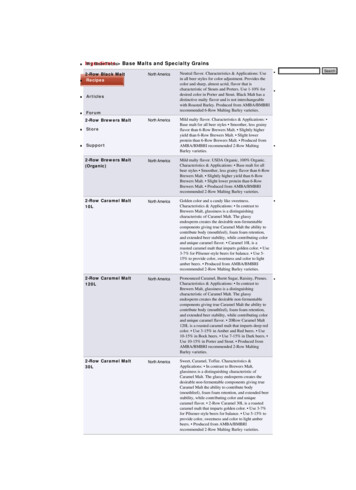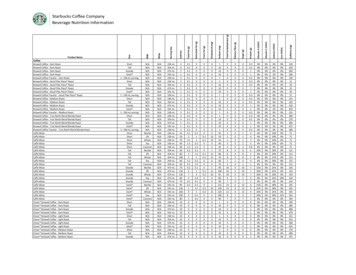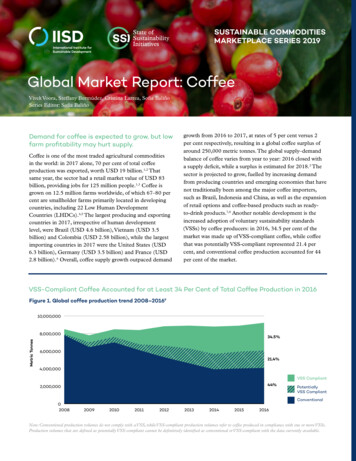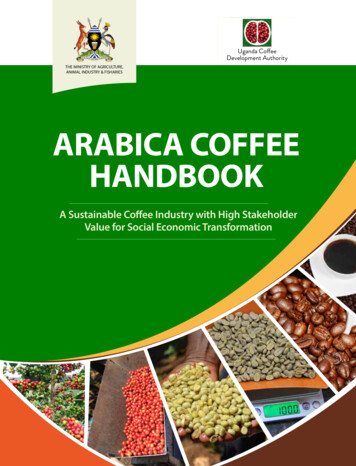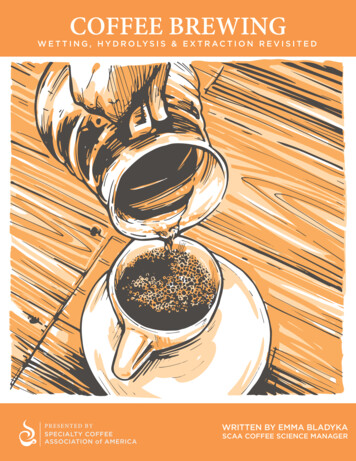
Transcription
COFFEE BREWINGW E T T I N G , H Y D R O LY S I S & E X T R A C T I O N R E V I S I T E DPR ESENTE D BYSPECIALTY COFFEEASSOCIATION of AMERICAWRITTEN BY EMMA BLADYKASCAA COFFEE SCIENCE MANAGER
COFFEEBREWINGWET TING, HYDROLYSIS & EXTR ACTION REVISITED“Brewing can be considered a personal taste adventure.”– Michael Sivetz, Coffee TechnologyBrewing is one of the most complex yet under-researched topics in coffee.The literature is sparse, much of the science is ancient, and our industryassumptions have been vast. In our SCAA education, we have alwaysstressed the three “stages” of brewing to be wetting, extraction, andhydrolysis (Lingle 2011). These terms have always seemed simple, vague,and mildly scientific, but have not yet been well defined and often leave uswith more questions than answers. Of course, we all know anecdotallyand theoretically how complicated coffee extraction is as a process,because we have been continually learning about it since our initiationinto coffee. I will preface this article by stating that, as we do not have allthe answers, there is much to learn!WETTINGFor coffee to be brewed it must first be wetted, which means the coffee grounds must absorb water.This is a physical process which can be explained via many simple yet interacting variables. First,we must consider that coffee is ground into a distribution of particle sizes. The size of the grounds,their density and placement/distribution in the bed of coffee, and the method of water additionwill all influence the speed of wetting. Certainly, if any external agitation occurs during thewetting phase, this will influence the speed and evenness of the process. We can think of the coffeebed as similar to a soil, where the rate of water infiltration depends on particle size and shape (e.g.gravel vs. sand), the initial moisture content of the particles, porosity, gas solubility, pressure, andparticle swelling (Hillel 2004).Coffee grounds, during wetting, swell and after the brewing is complete retain a proportion of thewater dispensed onto them, depending on particle size (Sivetz and Desrosier 1979; Mateus andothers 2007; Cammenga and others 1997). As air, volatile compounds, and other gases (primarilycarbon dioxide) are displaced during this wetting, we might notice an effervescence, or coffee“blooming” associated with it (Clarke and Macrae 1985). A portion of these gases can also bedissolved into the water or the coffee slurry. In certain brew methods, we can think of the wettingperiod as responsible for the “bloom” of the coffee. In other brew methods, such as those in theimmersion category, the wetting phase of brewing may take place very quickly. In espresso, certainmachine manufacturers have included a “pre-infusion” to allow the coffee bed to be wetted prior tothe main extraction event.1COFFEE BREWINGW E T T I N G , H Y D R O LY S I S & E X T R A C T I O N R E V I S I T E D
As coffee technicians and professionals, we usually like our coffee bed to be wetted in a uniformmanner, so that later the coffee can be extracted in a regular flow and time, but the best baristasknow that this to be an impossible task. Ideally, if we believe that the best coffee flavor comes fromevenly wet and extracted coffee particles, we try and minimize the deviation in grind size andwetting time. However, the jury is still out on the merits or drawbacks of a normal grind particledistribution! As with all coffee brewing – it is a matter of personal preference.EXTRACTIONAs the coffee grounds are wet, gases and volatile compounds are dissolved and lost, and solublecompounds are simultaneously drawn out from the coffee. This primarily occurs as chemical andphysical reactions between the coffee and the water, and we call it extraction. Really, the term canbe used in this context interchangeably with brewing, as the extraction process makes up the nuts& bolts of coffee brewing. Chemical engineers might call it “leaching” or “percolation” (Clarke1987; Petracco 2001). When chemists speak of extraction they are referring to the specificseparation of a particular substance from a mixture (or whole product). In our case, we areseparating many important soluble solids from a ground coffee product. When a product isbrought into contact with a solvent, some components of that product behave as soluble and othersas insoluble. In brewing, ground coffee is our product and water is the “universal” solvent. Intruth, without extraction, we would forever just have coffee grounds in water. It turns out, the term“extraction” that we use today refers to a few different types of reactions that are acting to transfercoffee solubles from coffee to water over time to create our coffee beverage. Currently, the methodthe coffee industry has to quantify extraction is as the percentage of solubles yield (aka brewingyield) from the amount of coffee grounds used to prepare the brew (Lingle 2011; Petracco 2001;Clarke 1987). This has generally been agreed upon to be ideal between 18-22% (Sivetz andDesrosier 1979; Lockhart 1957). Anything under or over that has been characterized, from asensory standpoint, by low extraction yields exhibiting a sour, sweet flavor and high extractionyields with bitter, astringent flavors, respectively (Petracco 2001; Rao 2010).Soluble compounds can exit the coffee grounds through a few different types of chemical reactions,all dependent on temperature, time, and agitation. In fact, they may go through more than one ofthe below processes. The chemical reactions which occur during coffee extraction are:DISSOLUTION PROCESSESWater solubility of compounds allows them to be dissolved into the water and hence extracted into thecoffee beverage. Examples include chlorogenic, acetic, malic, and other acids, caffeine and trigonelline(Arya and Rao 2007). There are two types of dissolution, named molecular and ionic for their mechanism. Compounds such as salts and acids usually dissolve ionically, as opposed to caffeine, whichdissolves molecularly. This Dissolution of water soluble compounds happens naturally when water movesover the coffee grounds during brewing.2COFFEE BREWINGW E T T I N G , H Y D R O LY S I S & E X T R A C T I O N R E V I S I T E D
HYDROLYSISHydrolysis is the name for a general chemical reaction that occurs when water reacts with anothercompound to alter it or break it down. During extraction, insoluble or large soluble coffee compoundscan be ‘loosened’ from the coffee particles via hydrolysis reactions (Cammenga and others 1997). This isone type of reaction that contributes to the extraction from coffee of solubles, typically larger organicacids. There is some debate as to how important this particular reaction is to coffee brewing (Clarke1987; Thaler 1979). When compounds go through hydrolysis go through the process of being ‘hydrolyzed’.DIFFUSION PROCESSESWherever solutes are not distributed uniformly throughout a solution, this creates a concentrationgradient. Consequently, solutes diffuse from zones of high concentration to where it is lower. In coffee,this means areas of high coffee concentrations (the grounds) to areas of low coffee concentration (thewater). An important particular case where these concentration gradients result in the diffusion ofcompounds is called osmosis. Osmosis is the net movement of solvent molecules through a membrane(in this case, a cell wall) into a region of lower solute concentration. This occurs in order to equalize thesolute concentrations on both sides of the “membrane” (the cell wall). This movement of molecules viadiffusion does not require stirring and would occur even without the active motion of gravity washingthe water over the coffee or other agitation. Diffusion can be calculated based on Fick’s Law, which statesthat diffusion is a function of time, temperature, liquid viscosity, layer depth, and solute concentration inboth the liquid and the solid, among other factors. Fick’s Law is fully described in the “Percolation”chapter of Illy & Viani (Petracco 2005b).IMPORTANT CONSIDERATIONSORDER OF REACTIONSWhat is important about the above ways by which soluble solids can be extracted from coffee intowater is that more than one of these forces can AND WILL be working simultaneously. As soon asan individual coffee particle is wetted and more water moves over its surface, it is going to startthe extraction process. This means that each individual coffee particle will have its own brew time.The solute concentration of the liquid (coffee) that is passing over coffee grounds will change as itflows through the coffee bed, therefore changing the diffusion rate via Fick’s Law. Finally, don’tforget that the brewed coffee itself will be going through many chemical reactions during thebrewing process, even after it has gone through a filtration medium and fallen into its brew reservoir.TEMPERATUREHeat is a key factor influencing coffee extraction, which has not been addressed fully in the aboveexplanation. Generally, as brewing temperature increases, coffee extraction (total and rate)increases (Merritt and Proctor 1959; Rao 2010). When compounds are broken down due to heat, itis called thermal degradation, this process largely occurs during roasting. We brew coffee with hotwater (generally agreed to be ideal between 195 and 205 F), and we know that heat accelerates allchemical reactions, as demonstrated by the Arrhenius equation (Petracco 2005b).3COFFEE BREWINGW E T T I N G , H Y D R O LY S I S & E X T R A C T I O N R E V I S I T E D
Heat also is known to increase the solubility of many chemical compounds. Thus, heat can work inthe two ways simultaneously to affect coffee extraction; acceleration of chemical reactions, and byincreasing the solubility of certain compounds.On the other side of the coin, when we brew coffee at room or refrigerated temperatures, we mustextend the brew time in order to get the “same” extraction, numbers-wise. Where the cold brewprocess lacks in temperature, it makes up for in time. Coffee solubles display significantlydecreased solubility in room temperature water. Increasing the brew time to hours instead ofminutes allows for maximal extraction of the solubles from the coffee grounds. That being said, wemust note that the two final beverages (hot and cold brewed) are not expected to exhibit the samechemical composition.There is much anecdotal and some scientific evidence that too much heat (temperatures above205 F) result in the extraction of bitter and astringent compounds, reducing the likeability of thebrewed coffee (Merritt and Proctor 1959; Andueza and others 2003; Sivetz and Desrosier 1979;Petracco 2001). In particular, the sensory perception of bitterness and astringency of coffee hasbeen found to increase with brewing temperature (Andueza and others 2003). Of course, in realitytemperature is not able to be examined as a single variable in the coffee brewing process, thusmaking it difficult to study.OTHERBREWING METHODCertain brewing methods transport additional components (not only coffee solubles) of the groundcoffee to the final beverage. A simple example is Turkish coffee, where suspended solid particles(spent grounds) keep swimming in the final beverage. Another case is espresso: an instance(probably the only one) where along with soluble material there is presence of an all-importantfraction of coffee oil, forming an emulsion (Petracco 2005a). However, the above lesson did notdescribe the intricacies of these methods.WATER CHEMISTRYWe are aware that certain aspects of water chemistry may affect the extraction of coffeecomponents. Some of the foundational research on this topic has been established for decades(Lockhart and others 1955; Campbell and others 1958; Pangborn and others 1971; Beeman andothers 2011; Lingle 2011). This work tended to focus on impurities, off-flavors, and holisticmeasurements of calcium and other dissolved solids. However, more recent research is beginningto shed light on the impact specific cations (calcium, magnesium, or potassium) in water have onthe extraction of different coffee constituents (Hendon and others 2014).4COFFEE BREWINGW E T T I N G , H Y D R O LY S I S & E X T R A C T I O N R E V I S I T E D
TIMEInteracting with temperature, time will certainly influence the amount of and type and amount ofcompounds extracted from coffee (Lee and others 1992). There is only very basic evidence ofspecific types of compounds in the coffee extract being reliably dependent on time (Merritt andProctor 1959). Ultimately, this is another variable in brewing coffee which can never be separatedfrom the other linked factors.COFFEE GRINDIn fact, it is practically impossible to extract soluble solids from coffee without grinding it. Ofcourse, the finer the grind, the smaller the particle size, the greater the surface area and thereforeadditional contact between coffee grounds and water (Clarke 1987). The grind size and shape thusis correlated with pore space of the coffee bed. The coffee grind has also been found to influencethe rate of caffeine extraction (Spiro and Selwood 1984).AGITATION/TURBULENCEFinally, if any turbulence/agitation occurs, including but not limited to the movement of waterthrough the coffee grounds, this will influence extraction. Certainly if the rate of flow aroundcoffee grounds is increased, this will lead to a higher rate of extraction.COFFEE QUALITYCertainly brewing method and coffee extraction can influence the hedonic evaluation of a coffeebeverage. However, we have to admit that we cannot make a defective, low quality coffee taste likea beautiful, high quality coffee via the brewing process. All processing and handling, freshness,flavor quality, and unique and favorable flavor characteristics can only be allowed to shine or bedestroyed during brewing. The heavy burden in this final step lies with the barista, and thus therole of extraction is the final act in the glorious opera that is the coffee chain.WHAT IS LEFT OVER?There are certain large molecules which are not extracted from the coffee. This could be for a fewreasons. First, the compounds might not be soluble in water. These compounds would be what wecall “water insoluble”. We generally consider a compound not soluble nor hydrolysable because oftheir chemical structure, orientation or size. We know these insoluble compounds to includemacro components of the coffee cell walls, which survive the roasting process (Petracco 2005b).These are polysaccharides such as cellulose and hemicellulose, and other polymers such as lignin(Arya and Rao 2007; Redgwell and others 2002; Fischer and others 2001). Hemicellulose iscomposed of three sugars, mannose being the most abundant, followed by galactose and arabinose,which are all found in the coffee cell wall (Mussatto and others 2011; Passos and others 2014).However, if these larger molecule are not hydrolyzed during a long, hot coffee extraction, they areoften left over. Larger molecules, such as proteins or those deriving from protein degradation canbe left in the coffee grounds.5COFFEE BREWINGW E T T I N G , H Y D R O LY S I S & E X T R A C T I O N R E V I S I T E D
For example, high molecular weight melanoidins largely remain in the spent coffee bed, whilesmaller melanoidins, grouped under the definition “soluble fibers,” are important to the brewinasmuch as they provide color and possibly taste and texture (Bekedam and others 2006;Bekedam and others 2008). Some ash and corresponding minerals are also not extracted into thecoffee brew, such as potassium (when not as salts), phosphorus, and magnesium, among others(Mussatto and others 2011).ACKNOWLEDGEMENTSSpecial thanks to Dr. Marino Petracco for his mentorship on this subject.LITERATURE CITEDAndueza S, Maeztu L, Pascual L, Ibáñez C, de Peña MP, Cid C. 2003. Influence of extractiontemperature on the final quality of espresso coffee. Journal of the Science of Food andAgriculture 83(3):240-8.Arya M, Rao LJM. 2007. An Impression of Coffee Carbohydrates. Critical Reviews in Food Scienceand Nutrition 47(1):51-67.Beeman D, Songer P, Lingle T. 2011. Water Quality Handbook, 2nd ed. Long Beach, CA: SpecialtyCoffee Assocation of America.Bekedam EK, Roos E, Schols HA, Van Boekel MAJS, Smit G. 2008. Low Molecular WeightMelanoidins in Coffee Brew. J. Agric. Food Chem. 56(11):4060-7.Bekedam EK, Schols HA, van Boekel MAJS, Smit G. 2006. High Molecular Weight Melanoidinsfrom Coffee Brew. J. Agric. Food Chem. 54(20):7658-66.Cammenga HK, Eggers R, Hinz T, Steer A, Waldmann C. 1997. Extraction in Coffee Processing andBrewing. Proc. 17th ASIC. Nairobi.Campbell CL, Dawes RK, Deolalkar S, Merritt MC. 1958. Effect of Certain Chemicals in Water onthe Flavor of Brewed Coffee. J. Food Sci. 23(6):575-7.Clarke RJ. 1987. Extraction. In: Clarke RJ, Macrae R, editors. Coffee: Volume 2: Technology. NewYork, NY: Elsevier Science Publishing Co., INC. p. 109-45.Clarke RJ, Macrae R. 1985. Coffee: Volume 1: Chemistry. New York, NY: Elsevier Applied ScienceLTF.Fischer M, Reimann S, Trovato V, Redgwell RJ. 2001. Polysaccharides of green Arabica andRobusta coffee beans. Carbohydrate Research 330(1):93-101.Hendon CH, Colonna-Dashwood L, Colonna-Dashwood M. 2014. The Role of Dissolved Cations inCoffee Extraction. J. Agric. Food Chem. 62(21):4947-50.Hillel D. 2004. Introduction to Environmental Soil Physics. USA: Elsevier Academic Press.Lee TA, Kempthorne R, Hardy JK. 1992. Compositional Changes in Brewed Coffee as a Function ofBrewing Time. J. Food Sci. 57(6):1417-9.Lingle TR. 2011. The Coffee Brewing Handbook, 2nd Edition ed. Long Beach, CA: Specality CoffeeAssociation of America.6COFFEE BREWINGW E T T I N G , H Y D R O LY S I S & E X T R A C T I O N R E V I S I T E D
Lockhart E, E. 1957. The Soluble Solids in Beverage Coffee as an Index of Cup Quality. New York,NY: Coffee Brewing Institute, Inc.Lockhart EE, Tucker CL, Merritt MC. 1955. The Effect of Water Impurities on the Flavor of BrewedCoffee. J. Food Sci. 20(6):598-605.Mateus M-L, Rouvet M, Gumy J-C, Liardon R. 2007. Interactions of Water with Roasted andGround Coffee in the Wetting Process Investigated by a Combination of PhysicalDeterminations. J. Agric. Food Chem. 55(8):2979-84.Merritt MC, Proctor BE. 1959. Extraction Rates for Selected Components in Coffee Brew. J. FoodSci. 24(6):735-43.Mussatto SI, Carneiro LM, Silva JPA, Roberto IC, Teixeira JA. 2011. A study on chemicalconstituents and sugars extraction from spent coffee grounds. Carbohydrate Polymers83(2):368-74.Pangborn RM, Trabue IM, Little AC. 1971. Analysis of Coffee, Tea and Artificially Flavored DrinksPrepared from Mineralized Waters. J. Food Sci. 36(2):355-62.Passos CP, Moreira ASP, Domingues MRM, Evtuguin DV, Coimbra MA. 2014. Sequentialmicrowave superheated water extraction of mannans from spent coffee grounds.Carbohydrate Polymers 103(0):333-8.Petracco M. 2001. Technology IV: Beverage Preparation: Brewing Trends for the New Millennium.In: Clarke RJ, VItzthum OG, editors. Coffee: Recent Developments. Ames, Iowa: Iowa StateUniveristy Press/Blackwell Science. p. 140-64.Petracco M. 2005a. Our Everyday Cup of Coffee: The Chemistry Behind the Magic. Journal ofChemical Education 82(8):1161-7.Petracco M. 2005b. Percolation. In: Illy A, Viani R, editors. Espresso Coffee: The Science ofQuality. San Diego, CA: Elsevier Academic Press.Rao S. 2010. Everything but Espresso: Professional Coffee Brewing Techniques. Canada.Redgwell RJ, Trovato V, Curti D, Fischer M. 2002. Effect of roasting on degradation and structuralfeatures of polysaccharides in Arabica coffee beans. Carbohydrate Research 337(5):421-31.Sivetz M, Desrosier NW. 1979. Coffee Technology. Westport, CT: The Avi Publishing Company,Inc.Spiro M, Selwood RM. 1984. The kinetics and mechanism of caffeine infusion from coffee: Theeffect of particle size. Journal of the Science of Food and Agriculture 35(8):915-24.Thaler H. 1979. The chemistry of coffee extraction in relation to polysaccharides. Food Chemistry4(1):13-22.7COFFEE BREWINGW E T T I N G , H Y D R O LY S I S & E X T R A C T I O N R E V I S I T E D
Brewing can be considered a personal taste adventure. – Michael Sivetz, Co ee Technology COFFEE BREWING ITED WETTING, HYDROLYSIS & EXTRACTION REVISITED COFFEE BREWING Brewing is one of the most complex yet under-researched topics in co ee. e literature is sparse, much of the science is ancient, and our industry assumptions have been vast.

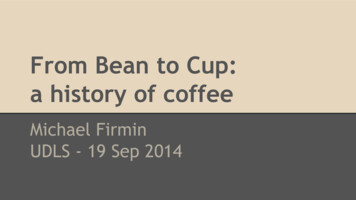
![[Ringle Material] 3rd wave coffee (Philz Coffee and Blue .](/img/22/2592b1ca.jpg)
